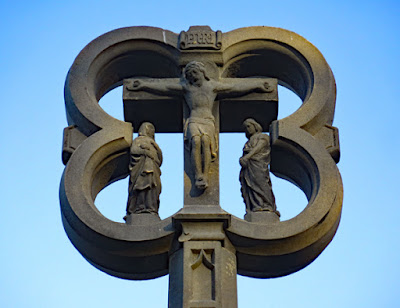 |
| A memorial at City Road Cemetery in Sheffield |
During the first part of my walk from Manor Top to Manor Lodge, I encountered various sculptures by Tom Clark, Thomas Kenrick and Ben Leach, which had been commissioned by Sheffield City Council in 2009 – as part of the City Road Project.
 |
| Sculptures outside the Gatehouse at Sheffield City Road Cemetery |
Walking down from the entrance to Manor Fields Park, there are two more large sculptures in this series – again carved in Crosland Hill sandstone – which flank the entrance to the City Road Cemetery, which has an impressive Grade II listed gatehouse.
 |
| Carrara marble and Hopton Wood stone |
I had briefly visited the cemetery a couple of times before but I had never been inside the Halls of Remembrance, where I was interested to see that that the niches used to inter the ashes contain inscriptions that are carved into panels of grey veined variety of Carrara marble - known in England as ‘Sicilian’ - and Hopton Wood stone.
 |
| Various stones used for monuments in City Road Cemetery |
Walking up past the crematorium, there are numerous large monuments with obelisks, urns, crosses and statues made in various granites and white Carrara marble, which were very popular during the Victorian period, and these provide an opportunity for students at all levels to study the mineralogical and physical characteristics of a wide range of stones.
 |
| The Cross of Sacrifice in City Road Cemetery |
Exploring the cemetery further, I came across a war memorial c.1920 designed by Sir Reginald Bromfield. The Commonwealth War Graves Commission style Cross of Sacrifice, together with its accompanying inscribed screen wall, is made out of Portland stone and this monument is protected with Grade II listed status.
 |
| The Belgian war memorial in City Road Cemetery |
Making my way quickly to the north entrance, I paused to look at the dilapidated Roman Catholic Mortuary Chapel, which was at last being repaired, and there I noticed another war memorial c.1920 in the form of a calvary – this time in memory of soldiers of the Belgian Army and of the refugees who died in Sheffield during the Great War.
 |
| A detail of the calvary at the Belgian war memorial |
Arriving at Manor Lodge, I had hoped to take another look around this interesting Tudor ruin – which is situated on high ground formed by sandstone of the Pennine Lower Coal Measures Formation but, I found it closed.
 |
| A view of Manor Lodge from Manor Lane |
Making my way down Manor Lane to the Manor Oaks Studios, where I briefly talked to a few of the artists, I carried on to the low ground upon which the Sheffield Parkway has been built, before catching the tram back to Sheffield city centre at Cricket Inn Road.
 |
| A view to the east from Manor Lane in Sheffield |
No comments:
Post a Comment